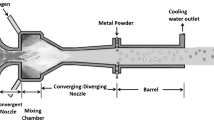Abstract
Hydrogen peroxide (H2O2) has its significance during the combustion of heavy hydrocarbons in the internal combustion (IC) engines. Owing to its importance the measurements of H2O2 dissociation rate have been reported mostly using the shock tube apparatus. These types of experimental measurements are although quite reliable but require high cost. On the other hand, numerical simulations provide low cost and reliable solutions especially using computation fluid dynamics (CFD) software. In the current study an experimental shock tube flow is modeled using open access platform OpenFOAM to investigate the thermal decomposition of H2O2. Using two different convective schemes, limitedLinear and upwind, the propagation of shock wave and resultant dissociation reaction are simulated. The results of the simulations are compared with the experimental data. It is observed that the rate constant measured using the simulation data deviates from the experimental results in the low temperature range and approaches the experimental values as the temperature is raised.
Similar content being viewed by others
References
“WiSTL Wisconsin Shock Tube Laboratory, Gas Dynamics Calculator.” Retrieved 14th June 2015, 2015, from http://silver.neep.wisc.edu/~shock/tools/gdcalc.html.
Anderson, J. D. (2003). Modern Compressible Flow with Historical Perspective. New York, Mc Graw Hill.
Bahrini, C., O. Herbinet, P.-A. Glaude, C. Schoemaecker, C. Fittschen and F. Battin-Leclerc (2012). “Quantification of Hydrogen Peroxide during the Low-Temperature Oxidation of Alkanes.” J. Am. Chem. Soc. 134: 11944–11947.
Bhaskaran, K. A. and P. Roth (2002). “The shock tube as wave reactor for kinetic studies and material systems.” (28): 151–192.
Bilwakesh, K. R., W. A. Strauss, R. Edse and E. S. Fishburne (1968). The Thermal Decomposition of Hydrogen Peroxide Vapor. Columbus, Ohio: 28.
Bonnie J. McBride, S. G., Martin A. Reno. (1993). “Coefficients for Calculating Thermodynamic and Trasport Properties of Individual Species.” Retrieved 16th August, 2015, from http://ntrs.nasa.gov/archive/nasa/casi.ntrs.nasa.gov/19940013151.pdf.
Brouwer, L., C. J. Cobos, J. Troe, H. R. Dubal and F. F. Crim (1987). “Specific rate constants k(E, J) and product state distributions in simple bond fission reactions. II. Application to HOOH -OH+OH.” J. Chem. Phys. 86: 6171.
Correa, S. M. (1993). “Turbulence-chemistry interactions in the intermediate regime of premixed combustion.” Combustion and Flame 93(1–2): 41–60.
Davenas, A., G. Jacob, Y. Longevialle and C. Perut (7-8 June 2004). Energetic Compounds for Future Space Applications. proc. '2nd Int. Conference on Green Propellants for Space Propulsion', Cagliari, Sardinia, Italy.
Direct, C. (2015). “OpenFOAM User Guide: 4.4 Numerical schemes.” Retrieved 14th June, 2015, from http://cfd.direct/openfoam/user-guide/fvSchemes/.
Forster, R., M. Frost, D. Fulle, H. Hamann, H. Hippler, A. Schlepegrell and J. Troe (1995). “High pressure range of the addition of HO to HO, NO, NO2, and CO.I. Saturated laser induced fluorescence measurements at 298 K.” J Chem. Phys. 103.
Fulle, D., H. F. Hamann, H. Hippler and J. Troe (1996). “High-pressure range of the addition of HOto HO.III. Saturated laser-induced fluorescence measurements between 200 and 700 K.” J. Chem. Phys. 105
Hong, Z., R. D. Cook, D. F. Davidson and R. K. Hanson (2010). “A Shock Tube Study of OH+ H2O2 -> H2O+HO2 and H2O2 + M -> 2OH + M using Laser Absorption of H2O and OH.” J. Phys. Chem. A 114: 5718–5727.
Hong, Z., D. F. Davidson and R. K. Hanson (2011). “An improved H2/O2 mechanism based on recent shock tube/laser absorption measurements.” Combustion and Flame 158: 633–644.
Hong, Z., A. Farooq, E. A. Barbour, D. F. Davidson and R. K. Hanson (2009). “Hydrogen Peroxide Decomposition Rate: A Shock Tube Study Using Tunable Laser Absorption of H2O near 2.5 micro meter.” J. Phys. Chem. A 113: 12919–12925.
Levine, I. N. (1991). Quantum Chemistry. Englewood Cliffs, New jersey, Prentice Hall.
Meyer, E., H. A. Olschewski, J. Troe and H. G. Wagner (1969). “Investigation of N2H4 and H2O2 decomposition in low and high pressure shock waves.” Symposium (International) on Combustion 12(1): 345–355.
Sajid, M. B., E. Es-Sebbar, T. Javed, C. Fittschen and A. Farooq (2013). “Measurement of the Rate of Hydrogen Peroxide Thermal Decomposition in a Shock Tube Using Quantum Cascade Laser Absorption Near 7.7 micro meter.” International Journal of Chemical Kinetics 46(5): 275–284.
Sangwan, M., E. N. Chesnokov and L. N. Krasnoperov (2012). “Reaction OH+ OH Studied over the 298-834 K Temperature and 1 -100 bar Pressure Ranges.” J. Phys. Chem. A 116: 6282–6294.
Sellevag, S. R., Y. Georgievskii and J. A. Milller (2009). “Kinetics of the Gas-Phase Recombination Reaction of Hydroxyl Radicals to Form Hydrogen Peroxide.” J. Phys. Chem. A 113: 4457–4467.
Trainor, D. W. and C. W. J. V. Rosenberg (1974). “Flash photolysis study of the gas phase recombination of hydroxyl radicals.” J. Chem. Phys. 61.
Troe, J. and V. G. Ushakov (2008). “SACM/CT Study of the dissociation/recombination dynamics of hydrogen peroxide on an ab initio potential energy surface Part II.Specific rate constants k(E, J), thermal rate constants k N (T), and lifetime distributions.” Phys. Chem Chem Phys. 10: 3915–3924.
Versteeg, H. K. and W. Malalasekera (2007). An Introduction to Computational Fluid Dynamics, The Finite Volume Method. Harlow, England, Pearson, Prentice Hall.
Westbrook, C. K. (2000). “Chemical Kinetics of Hydrocarbon Ignition in Practical Combustion Systems.” Proceedings of the Combustion Institute 28: 1563–1577.
Zellner, R., F. Ewig, R. Paschke and G. Wagner (1988). “Pressure and Temperature Dependence of the Gas-Phase Recombination of Hydroxyl Radicals.” J. Phys. Chem. 92: 4184–4190.
Author information
Authors and Affiliations
Rights and permissions
About this article
Cite this article
Bhatti, M.R., Sheikh, N.A., Manzoor, S. et al. Numerical study of hydrogen peroxide thermal decomposition in a shock tube. J. Therm. Sci. 26, 235–244 (2017). https://doi.org/10.1007/s11630-017-0935-6
Received:
Published:
Issue Date:
DOI: https://doi.org/10.1007/s11630-017-0935-6



